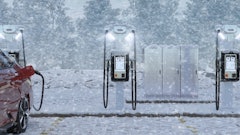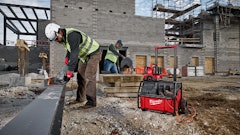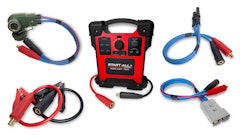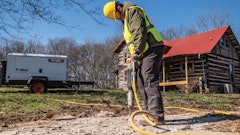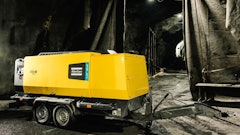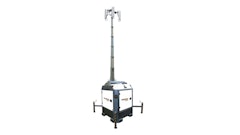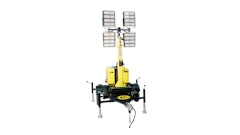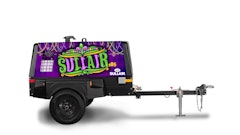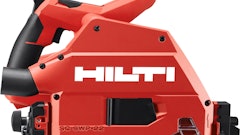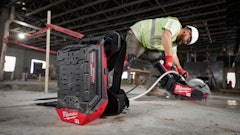
No matter how it’s done, the crucial component to powering a jobsite is just that—to make sure it’s sufficiently powered.
And, as with most anything, there are multiple ways to get there.
We recently spoke with manufacturers about the trends enabling power generation equipment to keep jobsites up and running for the long haul.
Alternative Fuel Sources
Similar to overarching trends in other segments, power generation equipment is leaning more toward sustainable fuel sources in recent years.
“There’s been a big push for green initiatives, and everybody’s looking for more fuel efficient, silent and green machines,” says Brian Tylisz, vice president and general manager for commercial and industrial NAM at Generac Power Systems. “Silence is a good byproduct of using a battery—there’s no engine. Solar power is completely zero emissions and requires no fuel. If contractors need to do construction in the evening in neighborhoods and be quiet, that’s a perfect solution.”
Tylisz adds that while Europe leads the charge (literally) in the electrification segment, he was surprised by the amount of construction pros recently asking for green power generation solutions.
“A lot of customers are focused on environmental social governance (ESG), and they have metrics they would like to meet as a company,” Tylisz says. “Renting these solutions helps them meet their ESG goals and claim their ESG credits.’’
Jorge Gutiérrez Torres, business development manager for sustainable energy solutions for the Americas for Atlas Copco, agrees.
“People really want to reduce their carbon footprint,” Gutiérrez Torres says. “There’s a transition to net zero. By reducing their carbon footprint, they also reduce their fuel consumption and therefore, their cost.”
Because the machines fall under sustainability initiatives and don’t produce any emissions, they can be used in a wider variety of applications, including in sensitive areas and indoors for applications such as manufacturing facilities.
“We have had the electric compressor since the 1950s, so this is not new for us,” says Marius Cristescu, marketing manager, CP Air Products at Power Technique North America, Chicago Pneumatic. “We know how to design, build, rent and service the electric compressor, so now it’s trying to penetrate markets like the construction market, where they’re not familiar with them or where they have always used diesel. The biggest success we’ve had is in rental applications where people are renting them in automotive or manufacturing industries.”
Battery power also means no engine, which translates to less labor required to maintain the machine.
“The newer technology requires less maintenance because you’re removing the radiator, which is required for engines,” says Jerel Cole, senior product manager at Hitachi Global Air Power. “You’re also getting rid of engine oil that requires more maintenance.”
Cristescu adds that users don’t have to fill the fuel tanks or change oil and engine filters.
“You have to grease the bearings every 500 hours, but that’s it,” Cristescu says. “It’s a massive difference in the amount of effort you put into an electric motor versus a diesel engine.”
In addition to lower maintenance, nixing diesel fuel—and its cost—is another reason rental companies and their customers are turning to alternative solutions. For example, Gutiérrez Torres notes that in some studies Atlas Copco has conducted, fuel savings with battery packs can range from $7,000 to $10,000—not counting the savings on maintenance.
“Because, in part, of the war in Ukraine, the cost of the diesel is very high,” Gutiérrez Torres says. “So, any reduction of fuel is really appreciated.”
John Cleary, vice president of sales for Western Global, adds that a lot of diesel generator fleets also require diesel exhaust fluid (DEF), another expense and potential supply chain hiccup.
“DEF is just another fluid end users have to deal with on the jobsite,” Cleary says. “There’s also a shortage of CDL drivers who have hazmat endorsements that can move fuel around, so it becomes more of a challenge on the jobsite for a fuel distributor to show up and fuel individual pieces of equipment.”
For operators hesitant about alternatively powered equipment, Cristescu says, as long as the jobsite can power the equipment, users shouldn’t encounter any challenges or learning curves with the equipment.
“We’re fighting with the perception that electric equipment isn’t as robust as diesel equipment, but it is,” Cristescu says. “If you have power on-site and someone who knows how to handle the cables, then it’s a no-brainer. Everything you need to know for an electric compressor, you already know from the diesel one.”
What to know
For some applications, alternative fuel sources alone may not be enough to cut it.
“Whenever we are talking about really high-demand energy applications, it is difficult to achieve today with the current technology,” Gutiérrez Torres says. “For example, with some electrical pumps that are in operation 24/7, the energy consumption at full load is high, and it can be challenging.”
Some sites may not yet have the charging infrastructure to support electric equipment, and for those that do, Cole says more forethought may be necessary.
“It’s going to require extra planning when utilizing this equipment because in some cases, you may not have as much run time with this equipment if you’re not tied to the grid,” Cole says. “However, over time, habits will change.”
While higher upfront cost is another reason the rental industry may shy away from electric equipment, Gutiérrez Torres says it is well worth the return on investment.
“There are incentives in most regions, and The Inflation Reduction Act is always helping,” Gutiérrez Torres says.
Hybrid Power
There is no rule saying that rental companies and their customers must choose between diesel power and other fuel sources.
That is where hybrid power and battery energy storage systems come into play.
Hybrid technology involves a combination of a diesel engine and another source of energy. A battery energy storage system can be charged by electricity generated from that renewable energy and also decide when to provide energy and when to store it.
“The diesel generator will operate under certain conditions, and the electric motor will take over for peak shaving conditions,” Cole says. “Using hybrid technology can lessen some of the anxiety operators have instead of going full battery power.”
What to know
Gutiérrez Torres notes that applications requiring a very high energy demand are not the most suitable, but otherwise, the systems can help end users save on maintenance and fuel costs.
“We can cover more than 70 percent of applications with hybrid systems,” Gutiérrez Torres says. “In most cases, we have large diesel generators with low loads, which is a very inefficient point for the diesel generator in terms of cost and maintenance.”
For example, running a diesel generator alone at a low load can result in wet stacking because the engine doesn’t reach a temperature high enough to burn all the diesel during combustion. In turn, unburned fuel leaves the engine and condenses in the exhaust system.
“That’s where we can use a hybrid system and work with the battery pack during the times when there are low loads and use the generator for higher loads,” Gutiérrez Torres says.
Efficiency Boosters
Aside from relying on different sources of energy, power generation equipment has become more efficient in other ways, as well.
Telematics
Many rental companies and end users can rely on telematics technology to get a full grasp on what their equipment is doing and where it’s located.
“Customers want to know where their equipment is, how many hours it’s running, whether there are any faults or warnings,” Cole says. “This will allow them to do remote troubleshooting and also allow for preventive maintenance to help improve uptime. A lot of telematics systems now allow for a deeper dive that enables rental companies to see trends for the machine over months at a time. Rental companies can analyze that data and take action if needed.”
For example, a rental company can monitor differential pressure via telematics, so if a machine is low on pressure because the filter is dirty, a technician can replace the filter before the machine shuts down.
Cole adds that many rental companies are accepting of telematics technology because it helps prevent downtime.
“Uptime is always critical in the rental market,” Cole says. “If a machine is down, the rental company isn’t collecting any rental rates. The more utilization an asset has, the more the company can grow and increase its fleet size.”
DEF tanks and fuel tanks
As previously mentioned, the cost and logistics of bringing in fuel and DEF to a site can cause headaches.
On sites where battery power and hybrid power are not an option, fuel tanks and DEF tanks can help cut down on the number of trips needed to fuel equipment.
“Before, a fuel distributor would show up and drive around to each individual piece of equipment to top it off,” Cleary says. “Now with a fuel tank, they can show up and drop more fuel into a single fuel tank. Also, instead of 90 gallons they might have put into the generator, now they’re dropping 500 gallons into the tank sitting right next to the generator.”
Cleary adds that fuel tanks also leave more room for delays.
“With the generators alone, the contractor could be only hours away from running out of fuel, so if anything stops that supply from being dropped off, that’s a problem,” Cleary says.
DEF tanks solve a similar problem.
Rather than having contractors out there dumping 2.5 gallons of DEF into the generator, there are now solutions that pair directly with the generator and have an automatic dispensing system to dose the generator with the amount of DEF it needs.
“The DEF tank is directly connected to the generator instead of wasting labor by humans dumping it in,” Cleary says.
As is the case with many technologies, Cleary says there may be resistance early on.
“It’s just one more piece of equipment to rent, and sometimes, it’s hard to get the contractor to understand why that’s necessary,” Cleary says. “However, the contractors are going to start to understand because rental companies selling the solution can explain why they will come out better money wise because they’ll be paying for less fuel.”
Intelligent technology
Manufacturers are also looking at artificial intelligence.
“The product offerings on machines will become more autonomous, and we’ll see more smart machines to prevent shutdowns,” Cole says. “For example, a machine may go into limp mode instead of shutting down completely in an adverse condition. The machines will become more self-correcting.”
What’s next
In addition to battery-powered solutions becoming more efficient and improvements to the infrastructure to support it, rental companies may start to see hydrogen-powered products gain a foothold in the market.
“It seems to be that right now, a lot of the larger rental companies are interested in it, but I was amazed by the amount of traffic to see our hydrogen generator at the 2023 CONEXPO Show,” Tylisz says. “It’s very groundbreaking, and while it’s expensive now, as it becomes more popular, the cost will come down.”
To fully implement hydrogen technology, the infrastructure must be in place to support it.
“The challenges are the supply chain and storage of hydrogen,” Cleary says. “There’s always that chicken and egg situation: I could show up with an entire jobsite full of hydrogen generators, but if you don’t have that supply chain of hydrogen behind it, then that doesn’t do you much good.”
All in all, the future of power generation may not come down to only one answer.
“As we know, not everything is reliable exactly when you need it. You may have solar or backup with vegetable oil or hydrogen, but the key will be storing the energy,” Gutiérrez Torres says. “Who knows who is going to win? The future will likely be a mix of different power sources.”
Recycle it
When the health of batteries is below 20 to 30 percent, the battery is no longer usable, and it’s time to think about recycling them, says Gutierrez.
But where?
“Thanks to electric vehicles, recycling centers are popping up everywhere,” Gutierrez says.
Rental companies should research recycling centers in their area that take unviable batteries. In some cases, Gutierrez says the battery may no longer be usable when it falls below a 60 percent state of health.
“In those cases, batteries can be sold to a secondhand application, for example, stabilization for frequency and voltage, and they can play a key role in that new job,” Gutierrez says.
Safety first
Like with any piece of machinery, safety should be top of mind when using power generation equipment.
Here are a few tips to keep rental companies and their customers safe:
- Perform daily checks on the machine, making sure there are no leaks or broken parts.
- Become familiar with the machinery by reading the owner’s manual and watching training videos.
- Develop safety programs and trainings so operators know what to expect from the machine.
- Provide ample warning labels and ample guarding for situations where there may be a threat to the operator.







